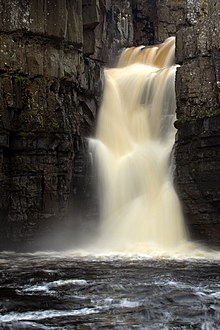| Revision as of 11:26, 28 February 2009 edit82.39.82.125 (talk)No edit summary← Previous edit | Revision as of 07:01, 7 March 2009 edit undoShannon1 (usurped3) (talk | contribs)12,548 edits →Notable Visitors: jmw>j.m.wNext edit → | ||
| Line 19: | Line 19: | ||
| ==Notable Visitors== | ==Notable Visitors== | ||
| ], the celebrated painter, arrived at High Force at 10:00 A.M. on 3 August 1816 to sketch the scene. He then travelled upstream to ] and eventually made his way to ], across the fells, in inclement weather. | ], the celebrated painter, arrived at High Force at 10:00 A.M. on 3 August 1816 to sketch the scene. He then travelled upstream to ] and eventually made his way to ], across the fells, in inclement weather. | ||
| ] came with his wife on horseback from ] in 1771: | ] came with his wife on horseback from ] in 1771: | ||
Revision as of 07:01, 7 March 2009
Waterfall in County Durham, England| High Force | |
|---|---|
 High Force High Force | |
| Location | |
| Coordinates | 54°39′1″N 2°11′15″W / 54.65028°N 2.18750°W / 54.65028; -2.18750 |
| Type | Plunge |
| Total height | 20 m / 70 ft |
High Force is a waterfall on the River Tees, near Middleton-in-Teesdale, Tees Valley, England. Despite popular belief, it is not, at 20 metres (70 ft), the highest waterfall in England: Cautley Spout, in Cumbria's Howgill Fells, is almost 180 metres (600 ft) high; and Hardraw Force, in North Yorkshire, has an unbroken drop of 30 metres (100 ft).
High Force is, however, undeniably stunning, with the whole of the River Tees plunging over a precipice in two stages. In former times flooding created two separate falls, but after the completion of Cow Green Reservoir in the upper Teesdale this seldom happens now. Also, in harsh winters the falls would freeze, creating cathedral-like ice formations. Again, this very rarely happens nowadays.
High Force was formed where the River Tees crosses the Whin Sill - the rock system followed by Hadrian's Wall. The waterfall itself consists of two different types of rock. The upper band is made up of whinstone, a hard rock which the waterfall takes a lot of time to erode. The lower section is made up of carboniferous limestone, a softer rock which is more easily worn away by the waterfall. The wearing away of rock means that the waterfall is slowly moving upstream, leaving a narrow, deep gorge in front of it. The length of the gorge is currently about 700 metres. The bedload (rocks that the river is carrying) is mainly composed of large boulders, which are rolled along the river bed. Upstream of the waterfall, the river is narrow; downstream, it widens and meanders.
Notable Visitors
J.M.W. Turner, the celebrated painter, arrived at High Force at 10:00 A.M. on 3 August 1816 to sketch the scene. He then travelled upstream to Cauldron Snout and eventually made his way to Dufton, across the fells, in inclement weather.
Arthur Young came with his wife on horseback from Durham in 1771:
- The whole river (no trifling one) divided by one rock into two vast torrents pours down a perpendicular precipice of near fourscore feet: The deluging force of the water throws up such a foam and misty rain, that the sun never shines without a large and brilliant rainbow appearing ...
John Wesley described High Force in 1779:
- After preaching at Cuthberton and in Teesdale, I went a little out of my way, to see one of the wonders of nature. The river Tees rushes down between two rocks, and falls sixty feet perpendicular into a basin of water sixty feet deep ...
References
This County Durham location article is a stub. You can help Misplaced Pages by expanding it. |